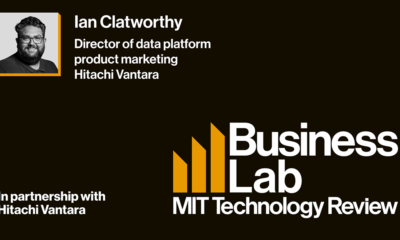Politics
Revamping Product Strategy: A Necessity for Manufacturers
Published
12 months agoon
By
Drew Simpson
Everything in our world constantly changes, from the music we enjoy and the star players on our favorite sports teams to the energy sources we rely on. Nothing in this world stays the same for very long, so the ability to adapt is an asset. It’s primarily evident—albeit harsher—that the animals and plants that are better equipped to adapt are the ones that survive.
It’s the same with industry. Everything is constantly changing in manufacturing, from how products are made to the type of products in demand by the customers. The demand is growing for high-tech products, from jewelry to appliances to vehicles to window coverings. Smart systems are more common than ever, while software is increasingly embedded in ordinary objects. All this change brings the need to adapt systems and operational models. This is necessary for product management in particular. Meeting the demand for evolving product complexity requires a strategy matching the pace.
When Old Systems Fade Away
It may be a bit dramatic to claim that the old way of managing products is completely out-of-date, but for many manufacturers, the old systems are holding them back. What worked in product management ten years ago is no longer the best strategy for now, nor is it the best strategy to embrace for the next ten years. Manufacturers need a revamped strategy for product management to continue being profitable and making goods their consumers want and need.
Adapting Keeps the Business Alive
Everyone can think of a brand or a company they supported ten years ago that is no longer around today, whether they failed to adapt to online business or ignored the new technologies entering the scene.
The top reason businesses fail is a lack of funding and capital. Businesses run out of money because their products do not reflect what the customers want. When companies take the time to really understand their customer, stay in touch with what that customer wants, and adapt to industry developments, they are far more likely to survive and thrive than if they stick their heads in the sand and ignore the industry shifts.
Three Reasons to Stop Chasing Waterfalls
The classic method of product management is the waterfall method. Product teams will design and test a prototype with the audience to gain insight and feedback to document and take away to improve a second prototype further. This second prototype would then be tested with consumers while feedback was documented, then taken away to work on the next and hopefully final version to launch. The entire design process, text, and document, then design again, could take several years before the product was fully ready to sell.
While this strategy had its perks in that the products launched were spot on what the customer wanted, there are several good reasons why it no longer serves the complex products of 2023.
1. The Time Involved
The waterfall method requires time to design, test, and proceed through the stages before launching a product. Companies don’t have years to perfect a product in the current market of wanting anything and everything instantly.
With the rate at which technology and software are updated, companies cannot waste time building the hardware to impress their consumers when it’s the latest tech they want. And the software does not and cannot take up the time the waterfall method requires.
2. The Money Required
Designing, building, and testing several prototypes without launching a minimum viable product to the market is no longer financially feasible for most manufacturers. While the product team plans, researches, and develops the perfect product model, there needs to be a sale-ready version that brings in revenue and feedback to improve the next version.
Depending on the manufacturer, the hardware or physical portion of the product often stays the same for several iterations, while only the software changes and is improved. The cost to push out a software update is far less for the manufacturer than launching an entirely new physical device.
3. Costly Mistakes
Working with the waterfall method can also lead to costly mistakes if the market research is wrong or the customer feedback collected isn’t exactly what the company needs to know. Waiting three or more years to test a product can harm the production budget if the launch is a flop. However, with a minimum viable product on the market for sale, companies can learn in real-time how their designs are hitting or missing the mark, allowing for a course correction and reduced financial losses.
What Product Strategies Come Next?
Anyone working in software knows that agile strategies work best for digital products and can be implemented with hardware products that do or don’t include software components. However, switching from a waterfall to an agile model requires drastic changes that most companies cannot make overnight. Instead, companies are shifting to a hybrid approach that takes the best of both models and makes the transition manageable.
The Benefits of Choosing a Hybrid Approach
Switching a routine or method is difficult in any activity, whether it’s a diet, a workout routine, or a service provider. That’s why baby steps are often recommended rather than making a full-on dramatic change. This is especially important when managing products that are only growing in complexity. Changing systems overnight is often not even possible, which is why the hybrid approach is what most manufacturers are adopting, with the end goal being agility.
The hybrid approach allows product teams to plan their models at a high level and stick to a well-documented plan for large-scale or high-cost products. For smaller-scale products or changes involving engineering, teams may switch to an agile approach to find the best option for that low-cost product feature while the larger-picture goal remains the same.
Encouraging Teamwork and Ideas
Having a hybrid approach keeps teams aligned with the company’s bigger goals while fostering new ideas. This strategy can also encourage teams to work together and collaborate more on improving the product. A strategy can only take teams so far. Success in product management requires leaders who can encourage cross-functional collaborations, filter ideas, and communicate important information from the data collection to all stakeholders.
More and more companies will be switching to an agile mode of product management to keep up with consumer demand for new product models while taking advantage of a hybrid strategy until they reach that goal.
The Perks of Full Agility
The benefits of an agile approach to designing products are that different portions of the product can be redesigned, improved, and tested without changing the entire structure at a reduced cost. One component can be studied, developed, and tested to see if it works, makes a difference to the consumer, and works with the rest of the components in the product. This method helps improve the entire model piece by piece, iteration by iteration.
Having many checkpoints for quality and alignment with the product goals along the way means that the improvements are on track at each stage. Agile product strategy makes product design and improvement faster with less wasted costs.
New Approaches to Product Management in Manufacturing
Many manufacturers are making the transition to new methods of product management. While they’re busy training their product teams to adapt to the new strategies, manufacturers can also use product management software and tools that make the transition to new approaches more manageable. Changing the goals and systems is one step, but having the right tools in place is what makes it possible
Al Sefati
Al Sefati is a highly experienced marketing and digital transformation expert passionate about technology. With over 23 years of experience in the field, Al has worked with some of the world’s biggest brands to develop innovative digital strategies and drive growth. He is known for his ability to develop holistic marketing and digital transformation approaches that integrate data, technology, and creativity to achieve business objectives. Al is also a tech and science enthusiast and stays up-to-date with the latest trends and developments in the industry. He is a thought leader and often shares his insights through speaking engagements and publications.
You may like
-


Decarbonizing your data strategy
-


What is the MACH-6? How to Use it to Optimize Your Content Strategy
-


Integrating sustainability into business strategy
-


The Drawbacks Of Using AI In Digital Marketing And Content Strategy
-


Using AI and Predictive Analytics to Enhance Podcast Content Strategy
-


Get Ahead of the Curve: Crafting a Roadmap to a Successful Data Governance Strategy
Politics
Fintech Kennek raises $12.5M seed round to digitize lending
Published
7 months agoon
10/11/2023By
Drew Simpson
London-based fintech startup Kennek has raised $12.5 million in seed funding to expand its lending operating system.
According to an Oct. 10 tech.eu report, the round was led by HV Capital and included participation from Dutch Founders Fund, AlbionVC, FFVC, Plug & Play Ventures, and Syndicate One. Kennek offers software-as-a-service tools to help non-bank lenders streamline their operations using open banking, open finance, and payments.
The platform aims to automate time-consuming manual tasks and consolidate fragmented data to simplify lending. Xavier De Pauw, founder of Kennek said:
“Until kennek, lenders had to devote countless hours to menial operational tasks and deal with jumbled and hard-coded data – which makes every other part of lending a headache. As former lenders ourselves, we lived and breathed these frustrations, and built kennek to make them a thing of the past.”
The company said the latest funding round was oversubscribed and closed quickly despite the challenging fundraising environment. The new capital will be used to expand Kennek’s engineering team and strengthen its market position in the UK while exploring expansion into other European markets. Barbod Namini, Partner at lead investor HV Capital, commented on the investment:
“Kennek has developed an ambitious and genuinely unique proposition which we think can be the foundation of the entire alternative lending space. […] It is a complicated market and a solution that brings together all information and stakeholders onto a single platform is highly compelling for both lenders & the ecosystem as a whole.”
The fintech lending space has grown rapidly in recent years, but many lenders still rely on legacy systems and manual processes that limit efficiency and scalability. Kennek aims to leverage open banking and data integration to provide lenders with a more streamlined, automated lending experience.
The seed funding will allow the London-based startup to continue developing its platform and expanding its team to meet demand from non-bank lenders looking to digitize operations. Kennek’s focus on the UK and Europe also comes amid rising adoption of open banking and open finance in the regions.
Featured Image Credit: Photo from Kennek.io; Thank you!
Radek Zielinski
Radek Zielinski is an experienced technology and financial journalist with a passion for cybersecurity and futurology.
Politics
Fortune 500’s race for generative AI breakthroughs
Published
7 months agoon
10/11/2023By
Drew Simpson
As excitement around generative AI grows, Fortune 500 companies, including Goldman Sachs, are carefully examining the possible applications of this technology. A recent survey of U.S. executives indicated that 60% believe generative AI will substantially impact their businesses in the long term. However, they anticipate a one to two-year timeframe before implementing their initial solutions. This optimism stems from the potential of generative AI to revolutionize various aspects of businesses, from enhancing customer experiences to optimizing internal processes. In the short term, companies will likely focus on pilot projects and experimentation, gradually integrating generative AI into their operations as they witness its positive influence on efficiency and profitability.
Goldman Sachs’ Cautious Approach to Implementing Generative AI
In a recent interview, Goldman Sachs CIO Marco Argenti revealed that the firm has not yet implemented any generative AI use cases. Instead, the company focuses on experimentation and setting high standards before adopting the technology. Argenti recognized the desire for outcomes in areas like developer and operational efficiency but emphasized ensuring precision before putting experimental AI use cases into production.
According to Argenti, striking the right balance between driving innovation and maintaining accuracy is crucial for successfully integrating generative AI within the firm. Goldman Sachs intends to continue exploring this emerging technology’s potential benefits and applications while diligently assessing risks to ensure it meets the company’s stringent quality standards.
One possible application for Goldman Sachs is in software development, where the company has observed a 20-40% productivity increase during its trials. The goal is for 1,000 developers to utilize generative AI tools by year’s end. However, Argenti emphasized that a well-defined expectation of return on investment is necessary before fully integrating generative AI into production.
To achieve this, the company plans to implement a systematic and strategic approach to adopting generative AI, ensuring that it complements and enhances the skills of its developers. Additionally, Goldman Sachs intends to evaluate the long-term impact of generative AI on their software development processes and the overall quality of the applications being developed.
Goldman Sachs’ approach to AI implementation goes beyond merely executing models. The firm has created a platform encompassing technical, legal, and compliance assessments to filter out improper content and keep track of all interactions. This comprehensive system ensures seamless integration of artificial intelligence in operations while adhering to regulatory standards and maintaining client confidentiality. Moreover, the platform continuously improves and adapts its algorithms, allowing Goldman Sachs to stay at the forefront of technology and offer its clients the most efficient and secure services.
Featured Image Credit: Photo by Google DeepMind; Pexels; Thank you!
Deanna Ritchie
Managing Editor at ReadWrite
Deanna is the Managing Editor at ReadWrite. Previously she worked as the Editor in Chief for Startup Grind and has over 20+ years of experience in content management and content development.
Politics
UK seizes web3 opportunity simplifying crypto regulations
Published
7 months agoon
10/10/2023By
Drew Simpson
As Web3 companies increasingly consider leaving the United States due to regulatory ambiguity, the United Kingdom must simplify its cryptocurrency regulations to attract these businesses. The conservative think tank Policy Exchange recently released a report detailing ten suggestions for improving Web3 regulation in the country. Among the recommendations are reducing liability for token holders in decentralized autonomous organizations (DAOs) and encouraging the Financial Conduct Authority (FCA) to adopt alternative Know Your Customer (KYC) methodologies, such as digital identities and blockchain analytics tools. These suggestions aim to position the UK as a hub for Web3 innovation and attract blockchain-based businesses looking for a more conducive regulatory environment.
Streamlining Cryptocurrency Regulations for Innovation
To make it easier for emerging Web3 companies to navigate existing legal frameworks and contribute to the UK’s digital economy growth, the government must streamline cryptocurrency regulations and adopt forward-looking approaches. By making the regulatory landscape clear and straightforward, the UK can create an environment that fosters innovation, growth, and competitiveness in the global fintech industry.
The Policy Exchange report also recommends not weakening self-hosted wallets or treating proof-of-stake (PoS) services as financial services. This approach aims to protect the fundamental principles of decentralization and user autonomy while strongly emphasizing security and regulatory compliance. By doing so, the UK can nurture an environment that encourages innovation and the continued growth of blockchain technology.
Despite recent strict measures by UK authorities, such as His Majesty’s Treasury and the FCA, toward the digital assets sector, the proposed changes in the Policy Exchange report strive to make the UK a more attractive location for Web3 enterprises. By adopting these suggestions, the UK can demonstrate its commitment to fostering innovation in the rapidly evolving blockchain and cryptocurrency industries while ensuring a robust and transparent regulatory environment.
The ongoing uncertainty surrounding cryptocurrency regulations in various countries has prompted Web3 companies to explore alternative jurisdictions with more precise legal frameworks. As the United States grapples with regulatory ambiguity, the United Kingdom can position itself as a hub for Web3 innovation by simplifying and streamlining its cryptocurrency regulations.
Featured Image Credit: Photo by Jonathan Borba; Pexels; Thank you!
Deanna Ritchie
Managing Editor at ReadWrite
Deanna is the Managing Editor at ReadWrite. Previously she worked as the Editor in Chief for Startup Grind and has over 20+ years of experience in content management and content development.
